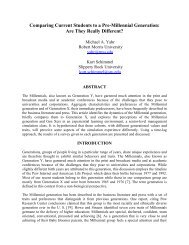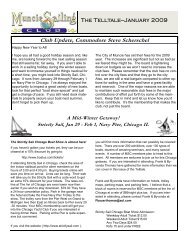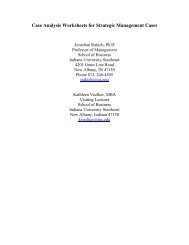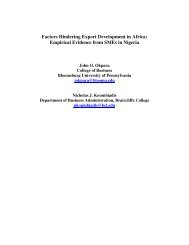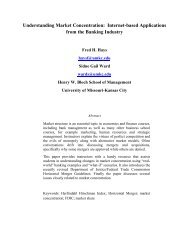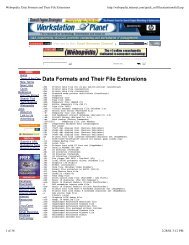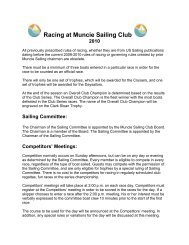Active versus Passive Management of International Mutual Funds ...
Active versus Passive Management of International Mutual Funds ...
Active versus Passive Management of International Mutual Funds ...
You also want an ePaper? Increase the reach of your titles
YUMPU automatically turns print PDFs into web optimized ePapers that Google loves.
fundamental indices resembled an active strategy, as fundamental indices cannot be held in<br />
equilibrium by every investor. Fundamental indexing requires a rebalancing at some time period<br />
and subjective choices must be made as to the construction <strong>of</strong> the index. These choices may<br />
include book value, sales, earnings, dividends, etc. [12].<br />
Cai and Houge [22] added support to active management fundamentals as they illustrated<br />
the impact <strong>of</strong> rebalancing the portfolio. They examined the annual additions and deletions <strong>of</strong> the<br />
Russell 2000 from mid 1979 through 2004. They found that a buy-and-hold strategy<br />
outperformed an annually rebalanced Russell 2000 by an average <strong>of</strong> 2.22 percent during the 1st<br />
year and by 17.29 percent for up to 5 years after reconstitution. These results suggested that<br />
index construction methodology may provide an incentive for portfolio managers to deviate from<br />
their benchmark styles [22].<br />
Arugaslan, Edwards, and Samant [8] conducted a study that evaluated the performance <strong>of</strong><br />
50 large U.S. based international equity funds for the period from 1994 to 2003 for a five-year<br />
and ten-year performance period. Their study utilized data from the Morningstar (2004) edition<br />
and compared returns to the Morgan Stanley Capital <strong>International</strong> Index Europe, Australia, and<br />
Far East Index and the S&P 500 index. Their study utilized quarterly data and calculated the<br />
Sharpe, Treynor, and Jensen measures. They then used the Modigliani and Miller M squared<br />
measure to evaluate the performance <strong>of</strong> the international funds to the benchmark indices. Their<br />
study found that once risk was included in the analysis <strong>of</strong> the highest performing funds investors<br />
may find them less attractive [8].<br />
Li [60], in one <strong>of</strong> the most recent studies regarding active <strong>versus</strong> passive management,<br />
found that a combination approach may be the better solution toward portfolio management. Li’s<br />
study analyzed the period from 1994 through 2008 using the data from the Morningstar database.<br />
By calculating Jensen’s Alpha, Li makes mutual fund allocation recommendations by investment<br />
categories [60].<br />
Bogle and Sullivan [15] reaffirmed the debate between active and passive investing.<br />
Bogle noted that the risks are dominated by money and vested interests as the view <strong>of</strong> Congress<br />
and the administration is short term. The changes will continue, because individuals own only<br />
24% <strong>of</strong> all stocks. The index fund is a good innovation, as investors will do better by simply<br />
owning the market at a low cost rather than owning the market at a high cost. If investors truly<br />
believe that the value <strong>of</strong> U.S. companies had not dropped by $9 trillion dollars in the last year,<br />
then there is value in owning the index [15]. By inference, one would have to believe noise has<br />
been created through the incorrect pricing <strong>of</strong> the securities and opportunities exist for<br />
fundamental indexing whether one believes it is passive or active.<br />
Summary<br />
The literature review has presented a chronological review <strong>of</strong> the evolution <strong>of</strong> the theory,<br />
thought, and status <strong>of</strong> the active <strong>versus</strong> passive management debate. The information presented<br />
started with the development <strong>of</strong> MPT and concluded with current thoughts <strong>of</strong> future investment<br />
within the global market.<br />
Bogle and Sullivan [15] identified the continued need for research in the passive <strong>versus</strong><br />
active management debate. Their inference <strong>of</strong> potential mispricing <strong>of</strong> the market securities due to<br />
the recession, pose an excellent foundation for either side to pr<strong>of</strong>ess the value <strong>of</strong> their strategy.<br />
Lehmann and Modest [59] illustrated the fact that a suitable benchmark was needed to<br />
measure the performance <strong>of</strong> actively and passively managed funds. To this end, researchers have<br />
used the S&P 500 index as the appropriate index to benchmark returns when comparing the two<br />
management styles. Since then researchers have incorporated various indices, such as the Russell<br />
18



